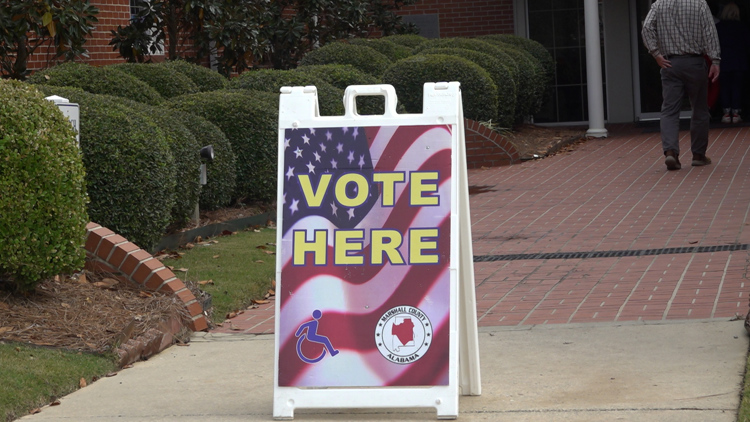MONTGOMERY, Ala. — Alabama shifted about 3% toward President-Elect Donald Trump in Tuesday’s election. But if unofficial returns are correct, that may have less to do with new Republican votes than a shrinking pool of Democratic ones.
Trump got about 1.4 million votes (65%) in Alabama on Tuesday, according to numbers from the Alabama Secretary of State’s office, while Vice President Kamala Harris, the Democratic presidential nominee, got about 766,680 (34%). About 58.5% of registered voters in Alabama participated in the election, the lowest number since 1988.
But Trump’s support was relatively unchanged from his numbers in 2020. According to the Secretary of State’s figures, Trump only added 11,540 votes to his total. Harris’ total fell by almost 82,000 votes — a drop of about 9.6% — over President Joe Biden’s numbers in 2020.
Experts say this shift points to declining Democratic engagement rather than a surge in Republican support.
Randy Kelley, chair of the Alabama Democratic Party, and several political science professors cited a lack of competitive races and stricter voting access rules as factors behind the lower Democratic turnout. John Wahl, chair of the Alabama Republican Party, pointed to sustained Republican outreach and demographic shifts as the GOP focuses on working-class and minority voters.
“They had many less Democrats on the ballot this time. They had few options to choose from,” Kelley said in a phone interview Wednesday.
Democratic turnout decreased across the state in both rural and urban areas with significant losses in traditionally Democratic strongholds. In Jefferson County, for example, Democratic votes dropped by 20,000, while Republican votes fell by 8,000. In rural counties, the decrease was even more notable; in Franklin County, Democratic turnout dropped by 25%, compared to smaller decreases among Republicans. Similar drops were seen in the Black Belt, where Lowndes County showed a 22% decrease in Democratic votes from 2020.
Kelley said the limited options available to voters, especially in Black candidates, discouraged turnout. Kelley noted that fewer Black candidates ran in 2024 and said that the party must improve its recruitment efforts.
“Candidates bring out their constituents, and without representation, it’s hard to get people excited about voting,” Kelley said.
Spencer Goidel, a political science professor at Auburn University, said that Alabama’s election landscape in 2024 lacked competitive races to encourage Democratic voters. Unlike in 2020, when then-incumbent Democratic U.S. Sen. Doug Jones’s campaign drew some left-leaning voters, the current election cycle offered limited engagement.
“If you’re a Democratic voter in Alabama, people can tell you it’s important to go out and vote, practice your civic duty, but at the end of the day, there’s not much of a reason to vote, and I think that that just filters down. It discourages people,” Goidel said.
In Alabama’s seven congressional districts, only District 2 had a Democratic candidate — Shomari Figures — in races considered somewhat competitive. Figures defeated Republican nominee Caroleene Dobson in the district on Tuesday.
Wahl said he believes a Republican focus on economic and educational issues may have contributed to Democrats’ smaller margins in these areas.
“We love to have these new minority voters coming to the Republican Party, kind of seeking refuge from how far left the Democrat Party has gone, and we’re excited about that,” Wahl said.


Enrijeta Shino, a political science professor at the University of Alabama, sees Alabama’s results as part of a national trend where Democratic turnout has dropped while Republican enthusiasm remained steady. Shino said the votes in Alabama mirrored a broader pattern nationwide.
“That shows that Republicans were more energized, probably did better in get-out-to-vote mobilization for their base, and the messaging that they were getting from Trump resonated with them better than the messages Democrats were getting from Harris with her base,” Shino said.”
Alabama’s restrictive absentee voting rules in 2024 also may have affected turnout. The state had effective no-excuse absentee voting in 2020 in response to the pandemic, but state officials ended that program after that election. The change especially affected low-income and hourly-wage workers who may face greater challenges voting in person.
“When you only have Election Day voting, the cost of voting for people is higher, and when the cost of voting for people is higher, you’re going to see people who can’t get off work or have to take care of their children, can’t afford child care, people like that are going to be less likely turn out to vote,” Goidel said.
This article originally appeared in the Alabama Reflector, an independent, nonprofit news outlet. It appears on FOX54.com under Creative Commons license CC BY-NC-ND 4.0.



